Design of Quad-Port Ultra-Wideband Multiple-Input-Multiple-Output Antenna with Wide Axial-Ratio Bandwidth
Abstract
:1. Introduction
2. Antenna Design
2.1. Antenna Element Design
2.2. CP UWB MIMO Antenna Design
3. Results Discussion
4. Conclusions
Author Contributions
Funding
Acknowledgments
Conflicts of Interest
References
- Liang, J.; Chiau, C.C.; Chen, X.; Parini, C.G. Study of a printed circular disc monopole antenna for UWB systems. IEEE Trans. Antennas Propag. 2005, 53, 3500–3504. [Google Scholar] [CrossRef]
- Baudha, S.; Yadav, M.V. A compact ultra-wide band planar antenna with corrugated ladder ground plane for multiple applications. Microw. Opt. Technol. Lett. 2019, 61, 1341–1348. [Google Scholar] [CrossRef]
- Chen, Z.N.; Ammann, M.J.; Qing, X.; Wu, X.H.; See, T.S.P.; Cai, A. Planar antennas. IEEE Microw. Mag. 2006, 7, 63–73. [Google Scholar] [CrossRef]
- Chen, Z.N. Antennas for Portable Device; Wiley: Hoboken, NJ, USA, 2007. [Google Scholar]
- Kowalewski, J.; Eisenbeis, J.; Tingulstad, M.; Kollar, Z.; Zwick, T. Design method for capacity enhancement of pattern-reconfigurable MIMO vehicular antennas. IEEE Antennas Wirel. Propag. Lett. 2019, 18, 2557–2561. [Google Scholar] [CrossRef]
- Kumar, P.; Urooj, S.; Alrowais, F. Design of quad-port MIMO/Diversity antenna with triple-band elimination characteristics for super-wideband applications. Sensors 2020, 20, 624. [Google Scholar] [CrossRef] [Green Version]
- Liu, F.; Guo, J.; Zhao, L.; Huang, G.; Li, Y.; Yin, Y. Dual-band metasurface-based decoupling method for two closely packed dual-band antennas. IEEE Trans. Antennas Propag. 2020, 68, 552–557. [Google Scholar] [CrossRef]
- OuYang, J.; Yang, F.; Wang, Z.M. Reducing mutual coupling of closely spaced microstrip MIMO antennas for WLAN application. IEEE Antennas Wirel. Propag. Lett. 2011, 10, 310–313. [Google Scholar] [CrossRef]
- Khan, M.S.; Capobianco, A.D.; Asif, S.M.; Anagnostou, D.E.; Shubair, R.M.; Braaten, B.D. A compact CSRR-enabled UWB diversity antenna. IEEE Antennas Wirel. Propag. Lett. 2017, 16, 808–812. [Google Scholar] [CrossRef]
- Rahman, M.; Ko, D.-S.; Park, J.-D. A compact multiple notched ultra-wide band antenna with an analysis of the CSRR-to-CSRR coupling for portable UWB applications. Sensors 2017, 17, 2174. [Google Scholar] [CrossRef] [PubMed] [Green Version]
- Park, J.-D.; Rahman, M.; Chen, H.N. Isolation enhancement of wide-band MIMO array antennas utilizing resistive loading. IEEE Access 2019, 7, 81020–81026. [Google Scholar] [CrossRef]
- Abbas, A.; Hussain, N.; Jeong, M.-J.; Park, J.; Shin, K.S.; Kim, T.; Kim, N. A rectangular notch-band UWB antenna with controllable notched bandwidth and centre frequency. Sensors 2020, 20, 777. [Google Scholar] [CrossRef] [PubMed] [Green Version]
- Iqbal, A.; Smida, A.; Mallat, N.K.; Islam, M.T.; Kim, S. A compact UWB antenna with independently controllable notch band. Sensors 2019, 19, 1411. [Google Scholar] [CrossRef] [PubMed] [Green Version]
- Yadav, R.; Malviya, L. UWB antenna and MIMO antennas with bandwidth, band-notched, and isolation properties for high-speed data rate wireless communication: A review. Int. J. RF Microw. Comput. Aided Eng. 2020, 30, e22033. [Google Scholar] [CrossRef]
- Sultan, K.S.; Abdullah, H.H. Planar UWB MIMO-diversity antenna with dual notch characteristics. Prog. Electromagn. Res. C 2019, 93, 119–129. [Google Scholar] [CrossRef] [Green Version]
- Deng, J.; Li, J.; Zhao, L.; Guo, L. A dual-band inverted-F MIMO antenna with enhanced isolation for WLAN applications. IEEE Antennas Wirel. Propag. Lett. 2017, 16, 2270–2273. [Google Scholar] [CrossRef]
- Sarkar, D.; Srivastava, K.V. Compact four-element SRR-loaded dual-band MIMO antenna for WLAN/WiMAX/WiFi/4G-LTE and 5G applications. Electron. Lett. 2017, 53, 1623–1624. [Google Scholar] [CrossRef]
- Ramachandran, A.; Pushpakaran, S.V.; Pezholil, M.; Kesavath, V. A four-port MIMO antenna using concentric square-ring patches loaded with CSRR for high isolation. IEEE Antennas Wirel. Propag. Lett. 2016, 15, 1196–1199. [Google Scholar] [CrossRef]
- Bhadade, R.S.; Mahajan, S.P. Circularly polarized 4 × 4 MIMO antenna for WLAN applications. Electromagnetics 2019, 39, 325–342. [Google Scholar] [CrossRef]
- Qu, L.; Piao, H.; Qu, Y. Circularly-polarized MIMO ground radiation antennas for wearable devices. Electron. Lett. 2018, 54, 189–190. [Google Scholar] [CrossRef]
- Choukiker, Y.K.; Sharma, S.K.; Behera, S.K. Hybrid fractal shape planar monopole antenna covering multiband wireless communications with MIMO implementation for handheld mobile devices. IEEE Trans. Antennas Propag. 2014, 62, 1483–1488. [Google Scholar] [CrossRef]
- Yao, Y.; Wang, X.; Chen, X.; Yu, J.; Liu, S. Novel diversity/MIMO PIFA antenna with broadband circular polarization for multimode satellite navigation. IEEE Antennas Wirel. Propag. Lett. 2012, 11, 65–68. [Google Scholar]
- Malik, J.; Patnaik, A.; Kartikeyan, M.V. Novel printed MIMO antenna with pattern and polarization diversity. IEEE Antennas Wirel. Propag. Lett. 2015, 14, 739–742. [Google Scholar] [CrossRef]
- Ullah, U.; Mabrouk, I.B.; Koziel, S. Enhanced-performance circularly polarized MIMO antenna with polarization/pattern diversity. IEEE Access 2020, 8, 11887–11895. [Google Scholar] [CrossRef]
- Adam, I.; Yasin, M.N.M.; Ramli, N.; Jusoh, M.; Rahim, H.A.; Latef, T.B.A.; Izam, T.F.T.M.N.; Sabapathy, T. Mutual coupling reduction of a wideband circularly polarized microstrip MIMO antenna. IEEE Access 2019, 7, 97838–97845. [Google Scholar] [CrossRef]
- Irene, G.; Rajesh, A. Dual polarized UWB MIMO antenna with elliptical polarization for access point with very high isolation using EBG and MSR. Prog. Electromagn. Res. C 2020, 99, 87–98. [Google Scholar] [CrossRef] [Green Version]
- Iqbal, J.; Illahi, U.; Sulaiman, M.I.; Alam, M.M.; Su’ud, M.M.; Mohd Yasin, M.N. Mutual coupling reduction using hybrid technique in wideband circularly polarized MIMO antenna for WiMAX applications. IEEE Access 2019, 7, 40951–40958. [Google Scholar] [CrossRef]
- Sharma, Y.; Sarkar, D.; Saurav, K.; Srivastava, K.V. Three-element MIMO antenna system with pattern and polarization diversity for WLAN applications. IEEE Antennas Wirel. Propag. Lett. 2016, 16, 1163–1166. [Google Scholar] [CrossRef]
- Malviya, L.; Panigrahi, R.K.; Kartikeyan, M.V. Circularly-polarized 2 × 2 MIMO antenna for WLAN applications. Prog. Electromagn. Res. C 2016, 66, 97–107. [Google Scholar] [CrossRef] [Green Version]
- Parbat, R.S.; Tambe, A.R.; Kadu, M.B.; Labade, R.P. Dual polarized triple band 4 × 4 MIMO antenna with novel mutual coupling reduction approach. In Proceedings of the IEEE Bombay Section Symposium-2015 (IBSS-2015), Mumbai, India, 10–11 September 2015; pp. 1–6. [Google Scholar]
- Kayabasi, A.; Toktas, A.; Yigit, E.; Sabanci, K. Triangular quad-port multi-polarized UWB MIMO antenna with enhanced isolation using neutralization ring. AEU-Int. J. Electron. Commun. 2018, 85, 47–53. [Google Scholar] [CrossRef]
- Akbari, M.; Ghalyon, H.A.; Farahani, M.; Sebak, A.R.; Denidni, T.A. Spatially decoupling of CP antennas based on FSS for 30-GHz MIMO systems. IEEE Access 2017, 5, 6527–6537. [Google Scholar] [CrossRef] [Green Version]
- Sharawi, M.S. Current misuses and future prospects for printed multiple-input, multiple-output antenna systems. IEEE Antennas Propag. Mag. 2017, 59, 162–170. [Google Scholar] [CrossRef]
- Balanis, C.A. Antenna Theory: Analysis and Design; Wiley Interscience: Hoboken, NY, USA, 2005. [Google Scholar]
- Blackwell, G.R. The Electronic Packaging Handbook; CRC: Boca Raton, FL, USA, 1999. [Google Scholar]
- Bisharat, D.J.; Liao, S.; Xue, Q. Wideband unidirectional circularly polarized antenna with L-shaped radiator structure. IEEE Antennas Wirel. Propag. Lett. 2016, 16, 12–15. [Google Scholar] [CrossRef]
- Bisharat, D.J.; Liao, S.; Xue, Q. Low-cost topologies of circularly polarized antennas for 5G applications. In Proceedings of the TENCON 2015—2015 IEEE Region 10 Conference, Macao, China, 1–4 November 2015; pp. 1–6. [Google Scholar]
- Blanch, S.; Romeu, J.; Corbella, I. Exact representation of antenna system diversity performance from input parameter description. Electron. Lett. 2003, 39, 705–707. [Google Scholar] [CrossRef] [Green Version]
- Feng, B.; Lai, J.; Zeng, Q.; Chung, K.L. A dual-wideband and high gain magneto-electric dipole antenna and its 3D MIMO system with metasurface for 5G/WiMAX/WLAN/X-band applications. IEEE Access 2018, 6, 33387–33398. [Google Scholar] [CrossRef]
- Zhu, J.; Li, S.; Feng, B.; Deng, L.; Yin, S. Compact dual-polarized UWB quasi-self-complementary MIMO/diversity antenna with band-rejection capability. IEEE Antennas Wirel. Propag. Lett. 2016, 15, 905–908. [Google Scholar] [CrossRef]
- Alsath, M.G.N.; Arun, H.; Selvam, Y.P.; Kanagasabai, M.; Kingsly, S.; Subbaraj, S.; Sivasamy, R.; Palaniswamy, S.K.; Natarajan, R. An integrated tri-band/UWB polarization diversity antenna for vehicular networks. IEEE Trans. Veh. Technol. 2018, 67, 5613–5620. [Google Scholar] [CrossRef]
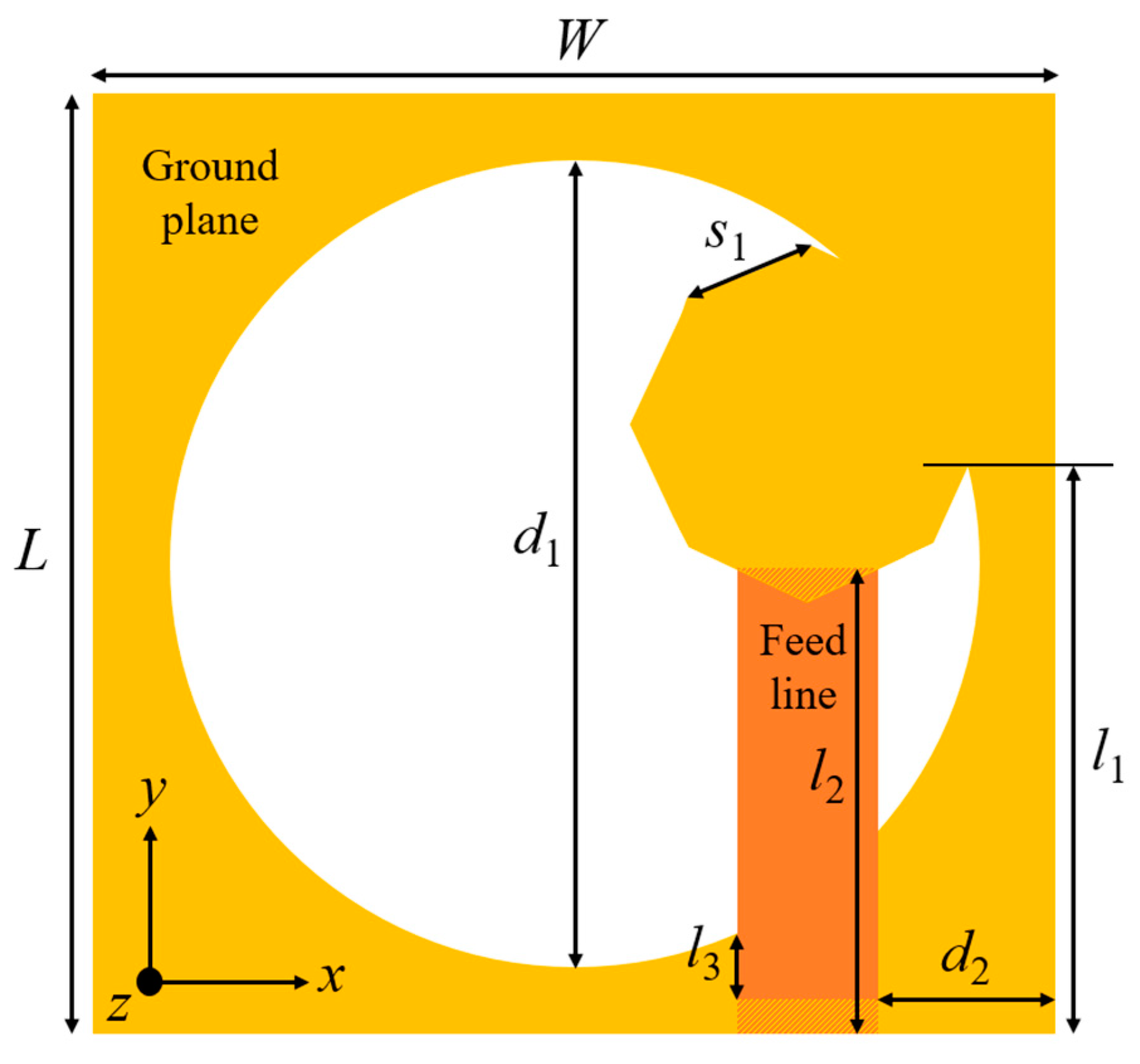
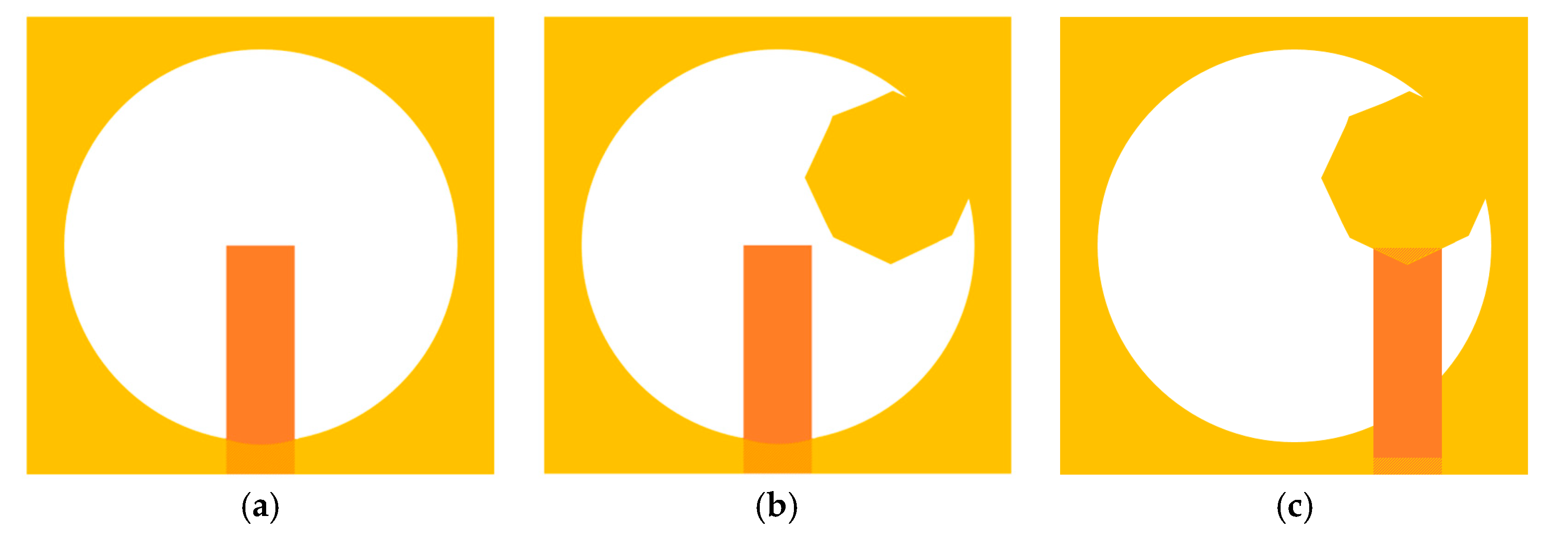
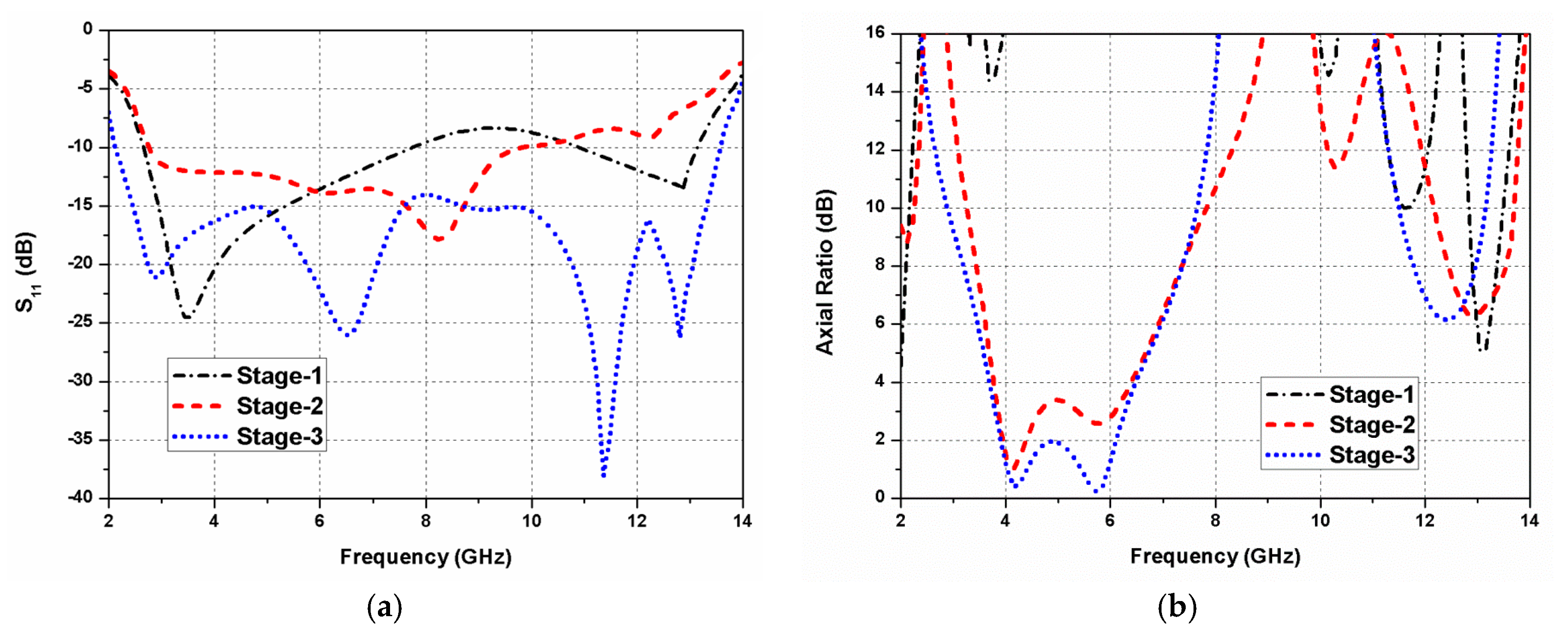






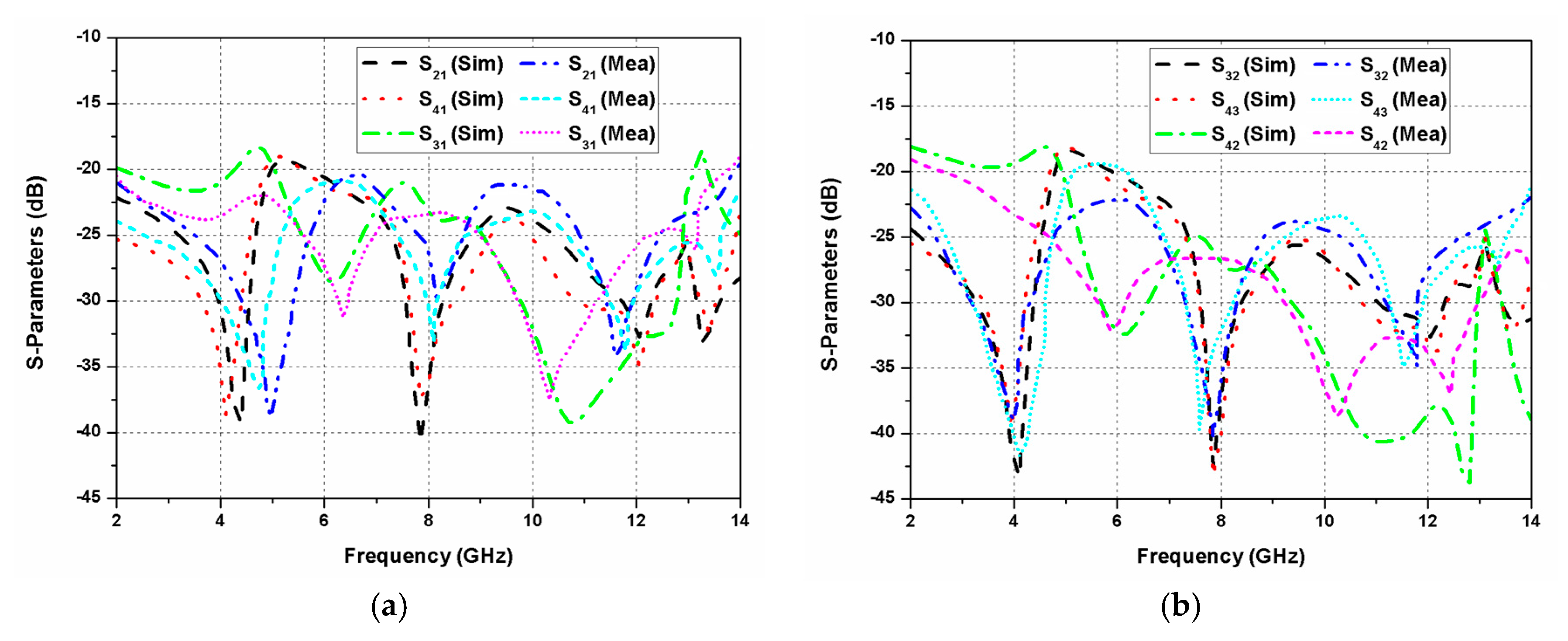

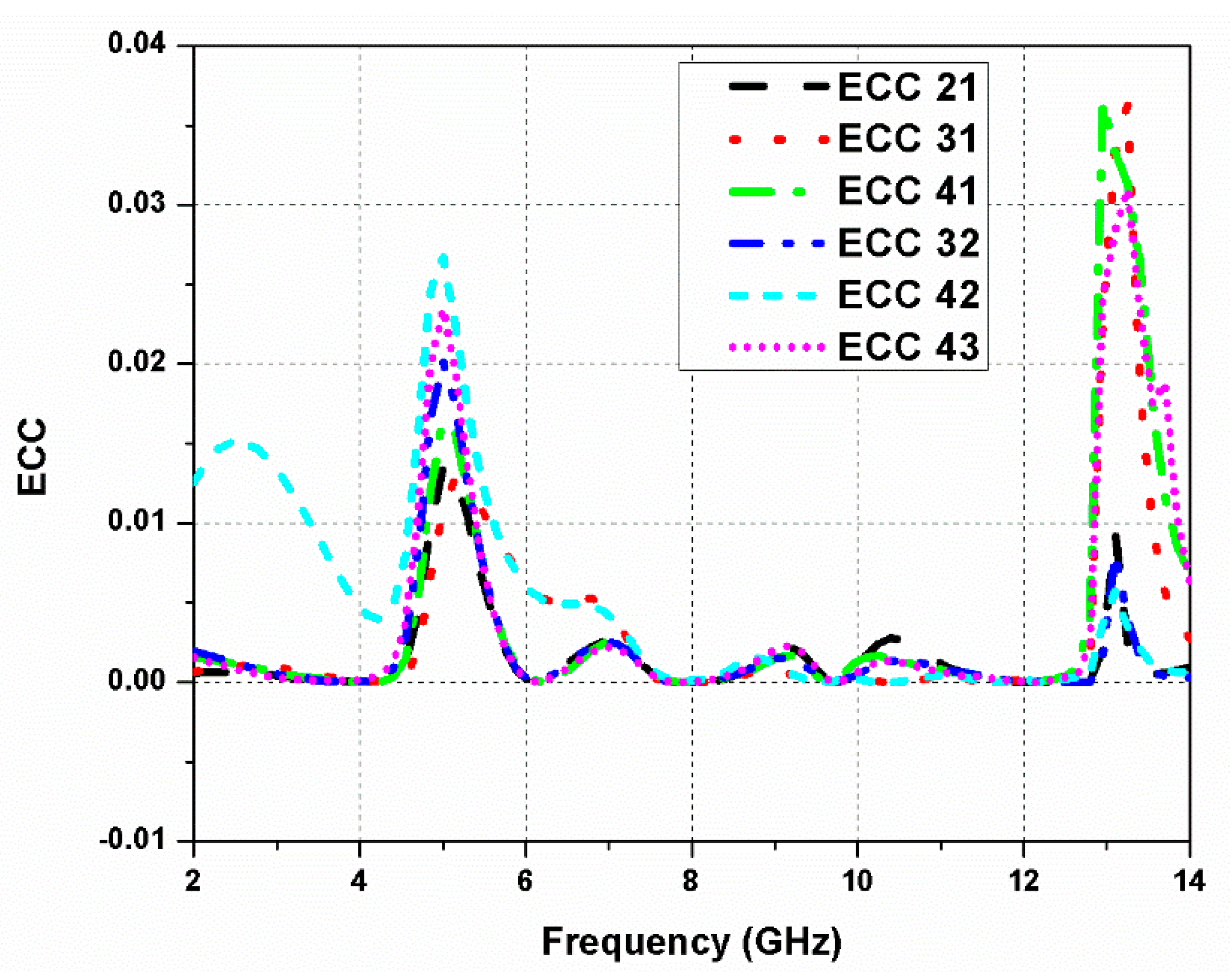
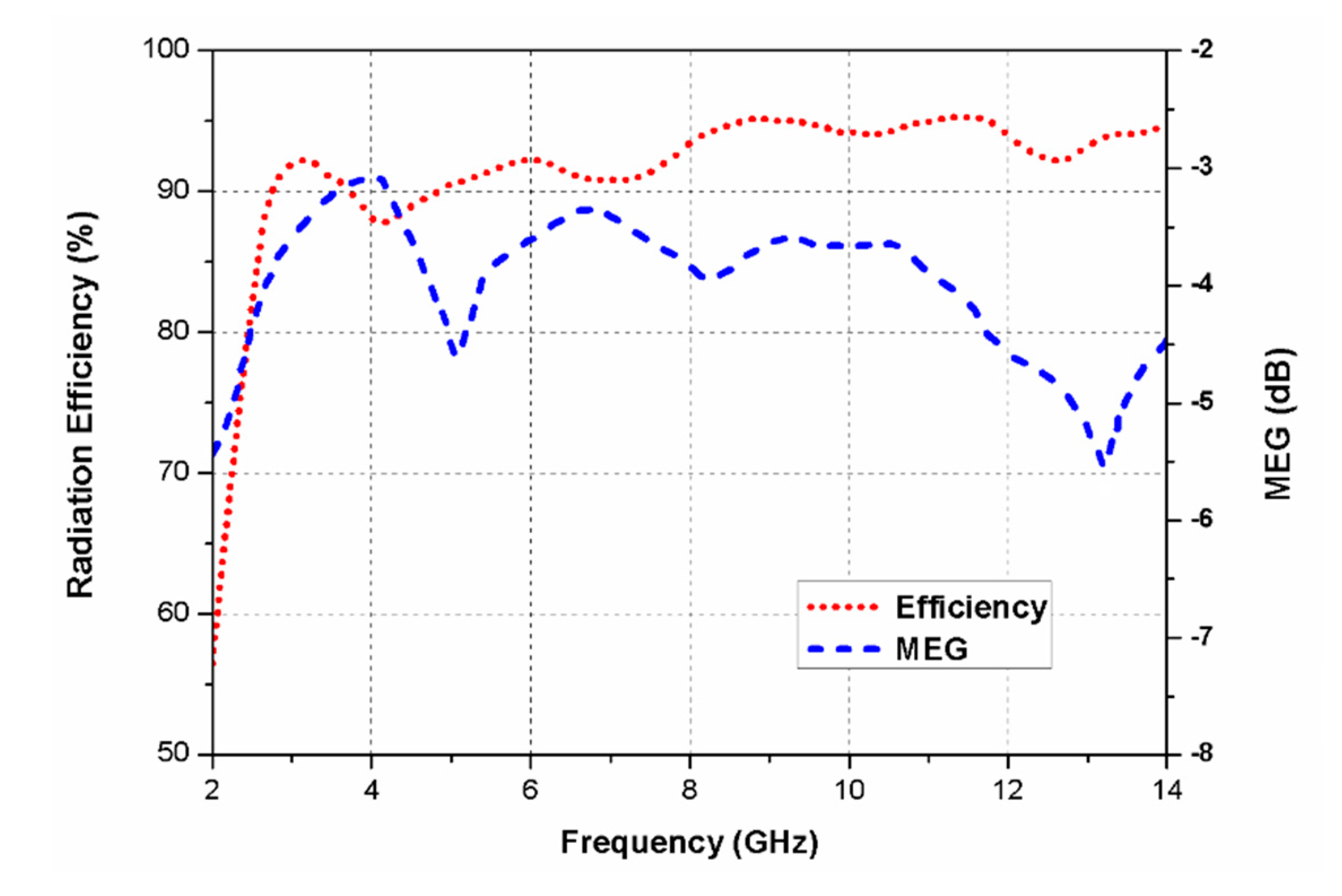
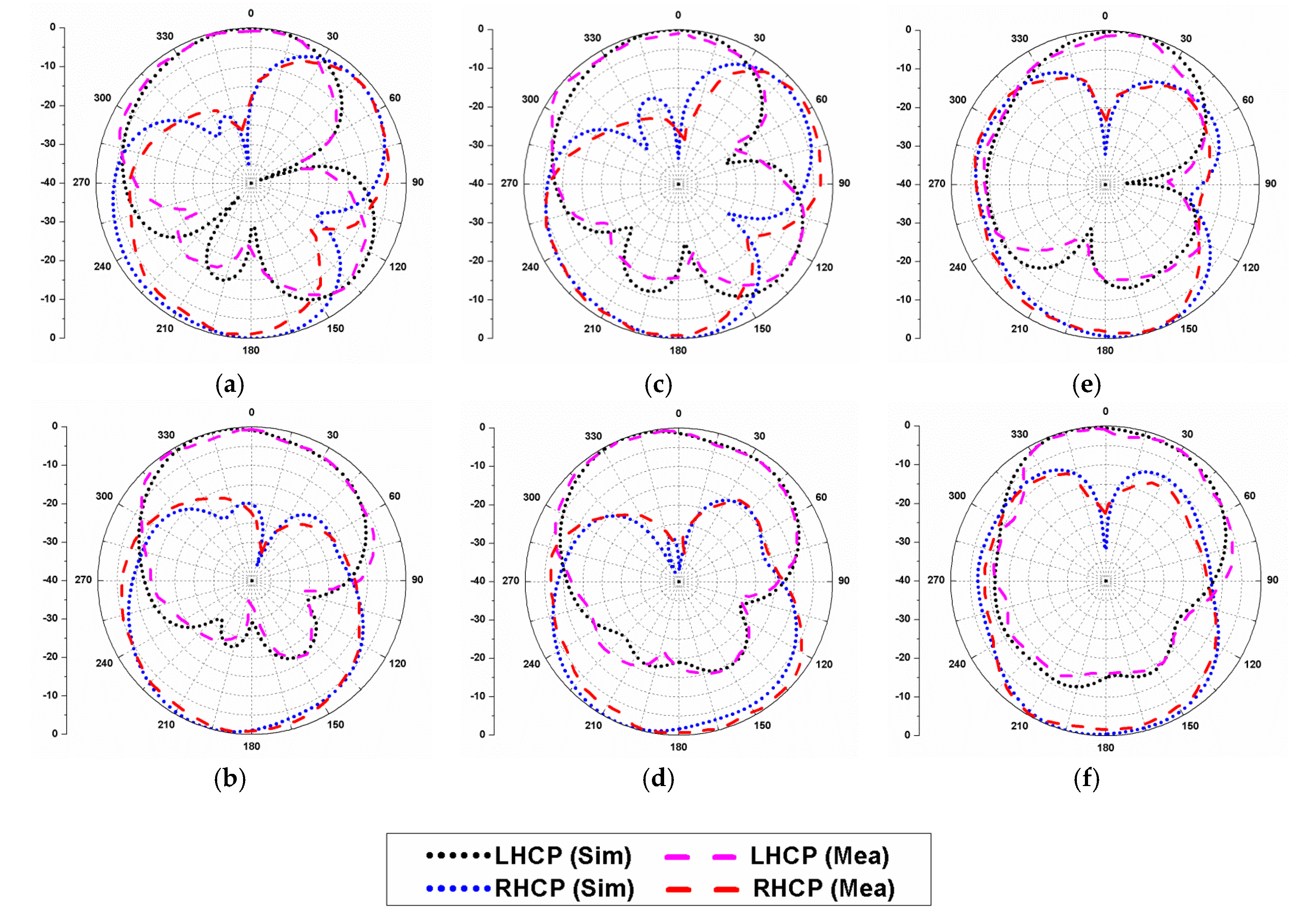
| Parameter | Dimension (mm) | Parameter | Dimension (mm) |
|---|---|---|---|
| L | 20 | L1 | 45 |
| W | 20 | W1 | 45 |
| l1 | 12.12 | l4 | 1 |
| l2 | 10 | l5 | 1 |
| l3 | 1.47 | l6 | 1 |
| d1 | 17.5 | d3 | 1 |
| d2 | 3 | d4 | 1 |
| s1 | 4 | d5 | 1 |
| Frequency (GHz) | Isolation (dB) | ADG (dB) | ECC |
|---|---|---|---|
| 4 | >19 | 9.98 | <0.01 |
| 8 | >26 | 10 | <0.01 |
| 12 | >26 | 9.9 | <0.01 |
| Ref. | No. of Radiators | 3-dB Axial Ratio Frequency (GHz) | ARBW (GHz)/(%) | Antenna Size (mm3) | −10 dB Impedance Frequency (GHz) | Effective Size | Impedance BW (GHz)/(%) | Gain (dB) | Isolation (dB) |
|---|---|---|---|---|---|---|---|---|---|
| [20] | 2 | 2.4–2.5 | 0.1/4 | 30 × 30 × 4 | 2.38–2.52 | 0.24λ0 × 0.24λ0 | 0.14/6 | — | >17 |
| [21] | 2 | — | — | 100 × 50 × 1.54 | 1.65–1.9, 2.68–6.25 | 0.55λ0 × 0.27λ0 | 0.25, 3.57/14, 80 | 6.78 | >15 |
| [22] | 2 | 1.1–1.7 | 0.6/43 | 94 × 94 × 1.6 | 1.02–1.72 | 0.32λ0 × 0.32λ0 | 0.7/51 | 2.65 | >14 |
| [23] | 2 | 5.5–5.9 | 0.4/7 | 30 × 25 × 1.524 | 5–6.8 | 0.5λ0 × 0.42λ0 | 1.8/31 | 4.4 | >14 |
| [24] | 2 | 5.2–6.3 | 1.1/18 | 13.7 × 36.2 × 15 | 5.2–6.3 | 0.24λ0 × 0.64λ0 | 1.1/18 | 5.8 | >20 |
| [25] | 2 | 2.04–2.57 | 0.53/23 | 66 × 66 | 1.82–2.57 | 0.4λ0 × 0.4λ0 | 0.75/34 | 4 | >24 |
| [26] | 2 | 6.5, 7.5 | — | 58 × 29 × 1.6 | 3.1–10.6 | 0.6λ0 × 0.3λ0 | 7.5/109 | 5.8 | >27 |
| [27] | 2 | 3.58–4.4 | 0.82/20 | 35 × 35 × 26.1 | 3.5–4.95 | 0.41λ0 × 0.41λ0 | 1.45/34 | 6.2 | >28 |
| [28] | 3 | 5.52–5.64 | 0.12/2 | 29 × 48 × 1.6 | 5.5–6.25 | 0.53λ0 × 0.88λ0 | 0.75/13 | 4 | >15 |
| [29] | 4 | 5.772–5.864 | 0.092/2 | 97 × 27.69 × 1.524 | 5.49–6.024 | 1.77λ0 × 0.51λ0 | 0.534/9 | 5.34 | >33 |
| [30] | 4 | 3.56–3.67, 5.16–5.29 | 0.11, 0.13/3, 2 | 165 × 165 × 1.6 | 1.71–1.88, 3.3–3.7, 5.15–5.35 | 0.94λ0 × 0.94λ0 | 0.17, 0.4, 0.2/9, 11, 4 | 5 | >45 |
| [31] | 4 | — | — | 75.19 × 75.19 × 1.6 | 3.1–17.3 | 0.78λ0 × 0.78λ0 | 10.2/139 | 5.5 | >13 |
| Prop. | 4 | 3.8–6.5 | 2.7/52 | 45 × 45 × 1.6 | 2.2–13.5 | 0.33λ0 × 0.33λ0 | 11.3/144 | 6.8 | >18 |
© 2020 by the authors. Licensee MDPI, Basel, Switzerland. This article is an open access article distributed under the terms and conditions of the Creative Commons Attribution (CC BY) license (http://creativecommons.org/licenses/by/4.0/).
Share and Cite
Kumar, P.; Urooj, S.; Malibari, A. Design of Quad-Port Ultra-Wideband Multiple-Input-Multiple-Output Antenna with Wide Axial-Ratio Bandwidth. Sensors 2020, 20, 1174. https://doi.org/10.3390/s20041174
Kumar P, Urooj S, Malibari A. Design of Quad-Port Ultra-Wideband Multiple-Input-Multiple-Output Antenna with Wide Axial-Ratio Bandwidth. Sensors. 2020; 20(4):1174. https://doi.org/10.3390/s20041174
Chicago/Turabian StyleKumar, Pawan, Shabana Urooj, and Areej Malibari. 2020. "Design of Quad-Port Ultra-Wideband Multiple-Input-Multiple-Output Antenna with Wide Axial-Ratio Bandwidth" Sensors 20, no. 4: 1174. https://doi.org/10.3390/s20041174






